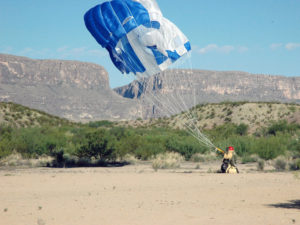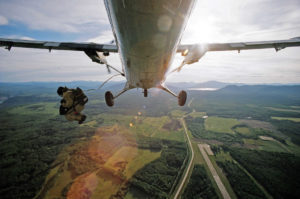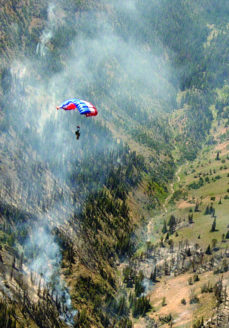Introduction
In the Wildland Firefighting community Smokejumpers are widely regarded as one of the most prestigious positions in the fire service. Smokejumpers are transported to fires in fixed wing aircraft, where they jump out at altitude and parachute down to the fire area. This seemingly wild process reduces response time to remote areas of the forest, and has allowed firefighters to access and attack fires long before heavy equipment could arrive. These seasoned firefighters utilize their vast fire knowledge, coupled with hand tools and chainsaws, to build a fire break around these newly sparked isolated incidents. Smokejumpers have a long history of fighting fire in some of the most secluded forested areas of the United States.

Smokejumper landing in a very open, and safe landing zone.
History of the Smokejumpers
Beginning in 1917, the United States Forest Service has been utilizing aircraft as a tool for fighting wildland fires. The first experiments in aviation consisted of dropping containers filled with water onto established wildfires in the hopes of achieving extinguishment. Some of the containers tested in these initial drops consisted of, 5 gallon tin cans, paper bags, and 8 gallon oak beer kegs, all of which proved to be failures. In 1934, T.V Pearson proposed using the relatively new technology of parachutes as a means of transportation for firefighters to be dropped near inaccessible wildland fires. This idea was quickly rejected by the government after a few demonstration jumps. In 1939 attention returned again to T.V. Pearson’s idea of parachuting into a fire. During this year 60 jumps were made into rough terrain simulating what it would be like to parachute into a fire area. In 1940, a crew of 6 Smokejumpers was put together in Winthrop, Washington, and another crew of 6 was staffed flying out of Moose Creek, Idaho. These newly appointed Smokejumpers jumped 9 fires during this first season. The results were finally a success with these crews reaching an early containment on these incidents, saving an estimated 30,000 dollars in suppression costs and property damage. This estimation was triple the cost of the initial investment on the Smokejumping program. Since the success of the first season of the program, Smokejumpers have only become more refined and efficient in their tactics and strategies.

Smokejumper leaving the plane with parachute ready to deploy.
Uses and Tactics of the Smokejumpers
Today this aerial fire suppression force typically jumps with anywhere from 8 to 16 personnel to an incident. The aircraft is loaded with supplies for the Smokejumpers that are designed for these firefighters to be self-sufficient for anywhere from 48 to 72 hours. The aircraft is also staffed with a spotter, which is typically one or two individuals with extensive smoke jumping experience that plays a support role for the firefighters on the ground. The spotter remains in the aircraft after the Smokejumpers make the initial jump to the fire. The spotter then relays critical information about fire activity, weather conditions, and other pertinent information that the Smokejumpers rely on to do their job safely. Once the firefighters are on the ground, they form and carryout the same duties and roles as a hand crew. They use hand tools and chainsaws to remove fuel, such as vegetation and other combustible material, from the fire’s path.
The Smokejumping program has proven to be one of the most influential and impacting projects related to fighting fires in the wildland. By opening up access to some of the most distant fires in the earliest stages, these potentially devastating disasters have a better chance to be suppressed before they cause any damage to lives or property. As time goes on, Smokejumpers tactics, strategies, and equipment will continue to become more refined and efficient. The combination of some of the best fixed wing and rotary aircraft paired with an elite fire fighting crew remains the most cost effective way to combat fires in desolate areas.
Sources:
https://www.fs.fed.us/fire/aviation/av_library/sj_guide/02_history_of_smokejumping.pdf
https://www.fs.fed.us/blogs/smokejumpers-out-sky-and-fire
https://afs.ak.blm.gov/fireops/fire-operations/smokejumpers-training.php
https://www.fs.fed.us/fire/people/smokejumpers/national-sj-users-guide.pdf





One Comment